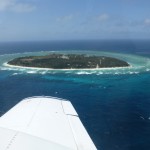
About an hour north of Brisbane, with about three hours driving left to reach Hervey Bay, the phone suddenly indicated we had gotten an unnoticed call. The barely listenable message said something about challenging weather conditions in the bay. “You might not want to travel on the boat today,” it warned.
We had booked one of the smaller whale watching vessels – half day, with lunch, whale sightings guaranteed – that travel twice a day out of the town of Hervey Bay during the prime spring season. Humpback whales migrate south then, surging and heaving from the waters. Many enter vast Hervey Bay itself, a flask of water between the mainland and huge Fraser Island, mistaking the bay for the open ocean. The result is that they are much easier to find in this contained space.
Anyone who loves nature and watching animals in their natural environment understands, however, that there are no guarantees. Birdwatchers know the often true dictum, “You should have been here last week when…” Species on those long lists compiled by reserves or forests are rarely seen without a lot of time, patience, dedication, knowledgeable guides, and mainly perhaps good luck. Besides, so many are nocturnal, you’d have to wander around in the dark to see them anyway.
In Daintree at the upper end of Queensland, for example, we were prowling the home of the ostrich-size cassowary. Everywhere on the road, signs warned of cassowary crossings; at every trail, signs alerted you to cassowary behavior. We saw none, except an ugly papier-mache sculpture at a visitor centre. (Click here to see our ode to the elusive bird.) And then at a trailhead, a local couple said, “You should have been here yesterday, when our daughter saw one in the parking lot.”
Though the whale watching boats deploy plane spotters overhead and sonar below, you never know what you will see, if anything.
As fickle as wild animals might be, weather and any number of unexpected circumstances can readily spoil an opportunity as well. We were in Australia long enough that we could pick the more optimal times to visit the different climate zones here. Nonetheless we’ve learned to carry our rainjackets everywhere no matter how sunny the forecast. And we well remember the avid birder who had booked our cruise to Antarctica and South Georgia Island primarily to see a single bird, known to exist on one island there. Stormy conditions made his one opportunity for a landing on the island too unsafe.
At Hervey Bay the problem was wind. Around the time we were heading north from Brisbane, the winds kicked up and shifted to northerly, stirring up the ocean and even more so the enclosed bay, like the sloshing of water back and forth in a bathtub. Now we’ve been through the turmoil of the Drake Passage on that Antarctica trip, so we weren’t too concerned about a turbulent bay.
But, just before we arrived at the harbor, we got the second call, cancelling the tour. Apparently, it was pretty bad out there. On the morning’s trip, the turbulence tossed paying tourists violently about and injured some, while messy seasickness prevailed. The conditions, we learned later, kept the boats moored for the next two days as well.
Sure, we were still here mainly to fly over to the reef at Lady Elliot Island, but this was a special opportunity to see whales – and we were both sorely disappointed. Nor did we see them during our dive trips off the island, as others had “just yesterday”.
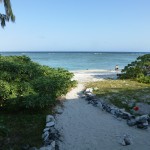
Still the reef life, not whales, was our main reason for being on the island, which is set right on the most southerly section of the Great Barrier Reef. The continuing northerlies even threatened that experience, making snorkeling areas west of the island unsafe and limiting options for diving because of the frothy sea. Fortunately, there were still plenty of wonders available to us.
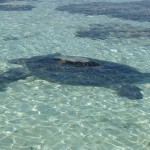
We spent much of our time exploring the “Lagoon,” the area within the reef encircling the island on its protected lee side. We could hardly believe the abundance. Several green turtles, blue spotted sting rays, schools of barracuda, a wondrous bull-ray over two meters wide with its long spade-like tail trawling behind, black-tipped reef sharks benignly cruising the waters, speckled giant clams and sea cucumbers, plus fish and coral in every color of the rainbow including iridescent. Another day and we might have missed any part of this.
Here’s some idea of what we saw in the Lagoon:
In diving, we had to face some strong currents underwater, and some nice sites were off-limits due to the weather, but down below was tranquil and extraordinary. The full richness of the Great Barrier Reef – from its plentiful fish to its abundant treetop coral – was still there to enjoy.
And here are some of the sights we saw among the bommies during a dive:
It helps that locals know where animals tend to hang out, like the cleaner stations where the big fish get manicured and primped by little fish. (Click here to read about our whale shark experience at Ningaloo Reef on the west coast.) Even so, our snorkel safari there couldn’t find the huge manta rays which typically gather in known spots. With wildlife, you never know what you will see.
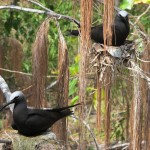
But then there was the unexpected. Lady Elliot had turned into a bird colony. Earlier than usual springtime weather had brought tens of thousands of white crested noddies onto the island to mate and nest in what seemed like every crook of every tree.
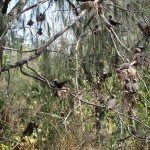
Joining them were huge flocks of crested, bridled and roseate terns as well as unusually friendly buff-banded rails, all literally within arm’s reach. Three infrequently seen red-tailed tropicbirds nested with chicks within a metre of a guest residence; elegantly soaring frigatebirds and sea-eagles swooped close overhead.
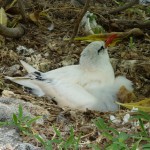
The island was aurally abuzz around the clock, with the clacking, cooing, kracking of birds – in the trees, on the ground, swirling overhead. No aviary could come close to the vitality of it all. Amazing!
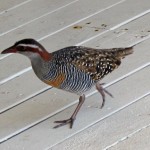
Disappointed as we were with missing out on the whales, we had little to complain about given the pleasures we were fortunate to enjoy. But that’s a lot of what travel is. Place yourself in a magnificent spot, we reflected, and then don’t worry so much about what you came to see; take pleasure in what you find.
The last afternoon on Lady Elliot, winds had started to shift. We were relaxing after a busy day of diving and snorkeling, sharing our satisfaction with the experience we did have despite the weather. We looked at the now calming sea beyond the reef outside the lagoon where we had spent so many thrilling hours.
There, we suddenly noticed white froth extending for, oh, it must be half a kilometer, and, oh, the foam is moving southward. We grabbed our binoculars. Then, for the next half hour, we were treated to a wild display of whale activity, as the humpbacks arced out of the water or rolled with their fins stretched to the sky. Some plunged so they “turned flukes” with their tails pointing first upwards, then slapped down, and, oh, several surged toward us, their bulky heads violently churning up the sea.
Sometimes you just need to get lucky.
___________
Coda: Our thoughts on dealing with lost opportunities –
- Count on disruption – You will miss a plane, train or boat; the weather will be foul; those darn animals won’t cooperate. You can try to remedy these disruptions; that’s where creativity and experience help. But be mentally prepared for what doesn’t go right, and be thankful if you’re lucky instead.
- Diversify your plans – Don’t count on seeing the one bird, or making the whole trip depend on narrow goals.
- Enjoy the space – If you’ve come to a special location, you’re likely to find a lot to enjoy, often not what you expected. We’ve rarely left a splendid place without realizing what more there was to do, if we had one more day, one more week. We know of people who have visited Europe to find themselves ensnared in a transit strike or found monuments closed or some such problem. Some fumed endlessly; others discovered that the best reason to be in Europe is the leisure to savor the culture by walking the streets, enjoying impossibly long meals, lingering in the piazzas amid the people.
- Relish what you do see – Embrace those remarkable experiences you were able to have; try to dismiss those you couldn’t (yes, control your emotions). We’ve found that people remember and recount the unanticipated delights in their visit even more than the predictable ones. You’re fortunate to have had those precious moments; feel it.
Besides, as they say in sports, there’s always next year.
(Also, for more pictures from Australia, CLICK HERE to view the slideshow at the end of the Australia itinerary page.)



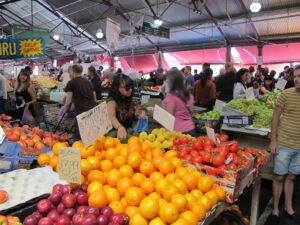
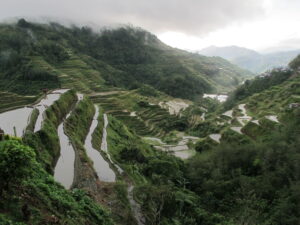
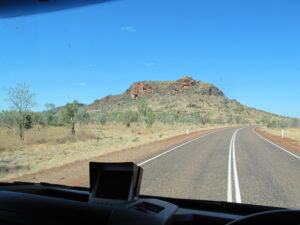
Great bird pics! I didn’t realize you had an underwater camera?!
The birds were most photogenic and cooperative. Also, at most dive shops, one can rent a GoPro underwater camera or equivalent…though we are considering adding one permanently to our electronic hardware.